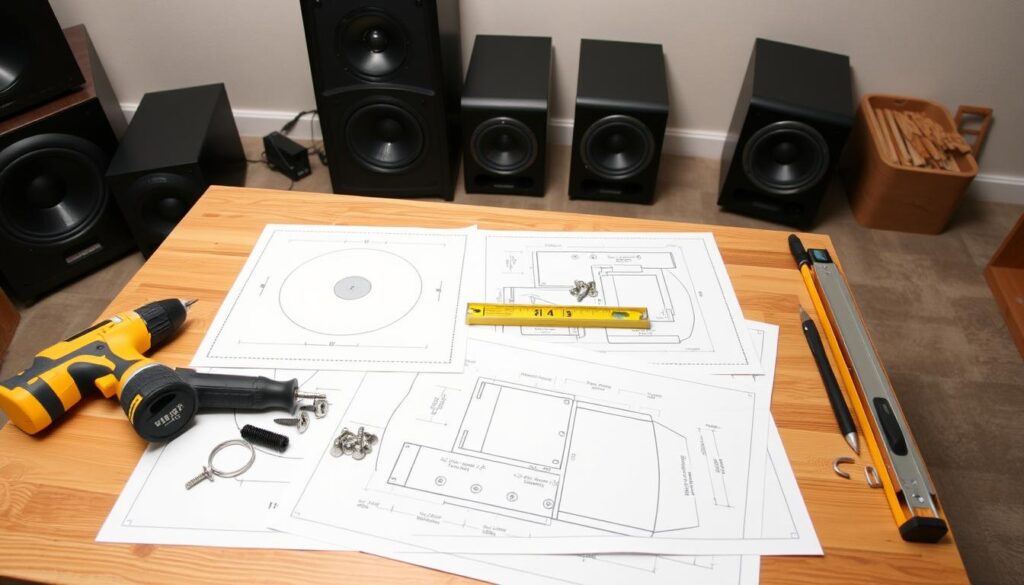
Ready to upgrade your car’s audio system? This guide will help you install a 5×8 speaker mount template. You’ll learn how to achieve professional results, even if you’re new to car audio.
Speaker mount templates are key for clean, precise installations. They ensure your new 5×8 speakers fit perfectly in place of stock 6×8 units. With the right approach, you’ll soon enjoy better sound quality.
This guide covers selecting materials and modifying your vehicle’s interior safely. You’ll discover essential tools, measurement techniques, and installation tips. These will help make your DIY car audio project successful.
Key Takeaways
- Speaker mount templates ensure precise fitting for 5×8 speakers
- Proper tools and safety equipment are essential for installation
- Accurate measurements are crucial for a successful template creation
- Careful cutting and modification of the mounting area is required
- Following safety precautions helps prevent damage to your vehicle
Understanding Speaker Mount Templates Basics
Speaker mount templates are vital for car audio installation. These cutout guides ensure precise speaker placement. They make your upgrade process smoother and more efficient.
What is a Speaker Mount Template
A speaker mount template matches the exact dimensions of your new speakers. It guides you when cutting holes in your car’s panels or doors. Templates are crucial when upgrading from 6×8 to 6×9 speakers.

Benefits of Using Templates
Templates offer many advantages in car audio installation. They provide precise fit and alignment. They also reduce installation errors and save time.
- Precise fit and alignment
- Reduced installation errors
- Time-saving during the mounting process
- Professional-looking results
Using mounting templates can greatly improve your speaker installation project. They help achieve professional-looking results with less effort.
Common Template Materials
Speaker mount templates come in various materials. Each material has its own benefits. Choose one that suits your needs and skill level.
- Cardboard: Inexpensive and easy to work with
- Plastic: Durable and reusable
- Metal: Precise and long-lasting
For beginners, cardboard templates are often the best choice. As you gain experience, you might prefer plastic or metal options. These are better for more complex car audio installation projects.
Required Tools and Materials
Planning a speaker installation? You’ll need the right tools for a smooth process. Let’s explore the essential equipment for your DIY audio project.
Essential Tools List
Your toolkit should include:
- Dremel or rotary tool with metal cutting wheels
- Drill with a 1/8″ bit
- Flathead screwdriver
- Mounting screws
- 3/8″ ratchet with extension
These tools help create precise cuts and secure speakers properly. A DIY speaker upgrade usually takes a couple of hours. Having the right equipment is key.
Safety Equipment Needed
Safety comes first. Don’t skip these items:
- Safety glasses
- Particle mask
- Ear protection
These precautions are crucial when using speaker installation equipment that makes dust or noise.
Optional But Helpful Items
To make your job easier, think about adding these:
- EZ-Lock cutting set for Dremel
- Grinding wheel attachment
- 3/16″ x 1/8″ gray weather stripping for vibration reduction

With these tools, you’re ready for your speaker mount installation. Check your hardware every three months. Do a full inspection once a year.
Safety Precautions and Preparation
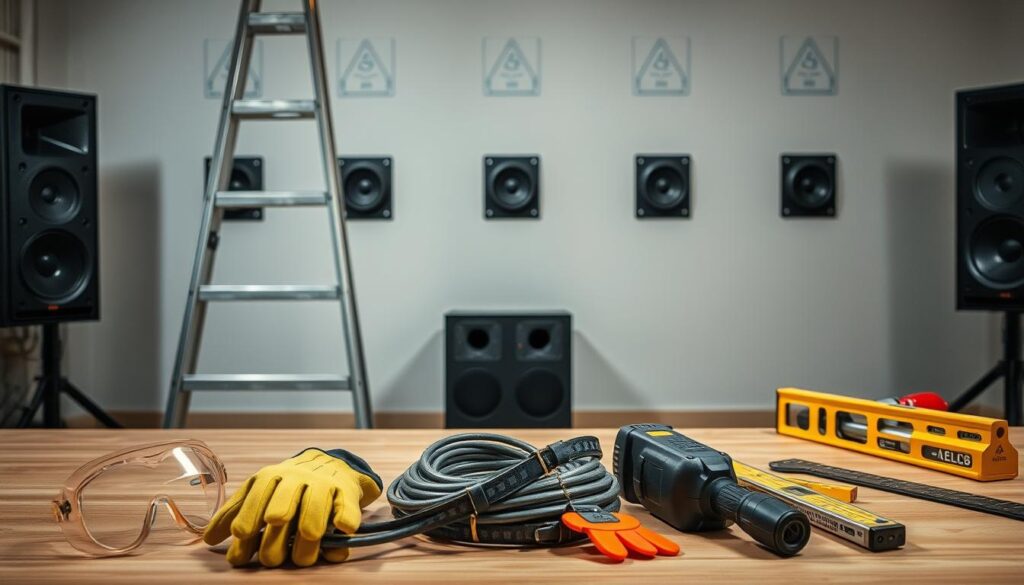
Safety is crucial for DIY speaker installation. Protect yourself from accidents and ensure a smooth project. Gather essential protective gear for your car speaker safety.
Shield your eyes with safety glasses. Use a dust mask to avoid inhaling particles. Wear a long-sleeved shirt to protect your skin. These precautions are vital for safe installation.
Before starting, take these important steps:
- Disconnect the car battery’s negative terminal
- Ensure proper ventilation in your work area
- Handle cutting tools with extreme care, especially near windows
- Keep a first aid kit nearby
Proper measurement and preparation are key to success. Set up your workspace carefully. Double-check your safety measures. Now you’re ready to install speakers safely and confidently.
Speaker Mount Template 5×8 Measurements and Specifications
Proper fit is key for 5×8 speaker installation. Knowing dimensions, mounting patterns, and clearance helps ensure a smooth setup.
Standard Dimensions
5×8 speakers typically measure about 5 inches by 8 inches. Sizes may vary slightly between brands. Always check your speaker’s exact dimensions before cutting or drilling.
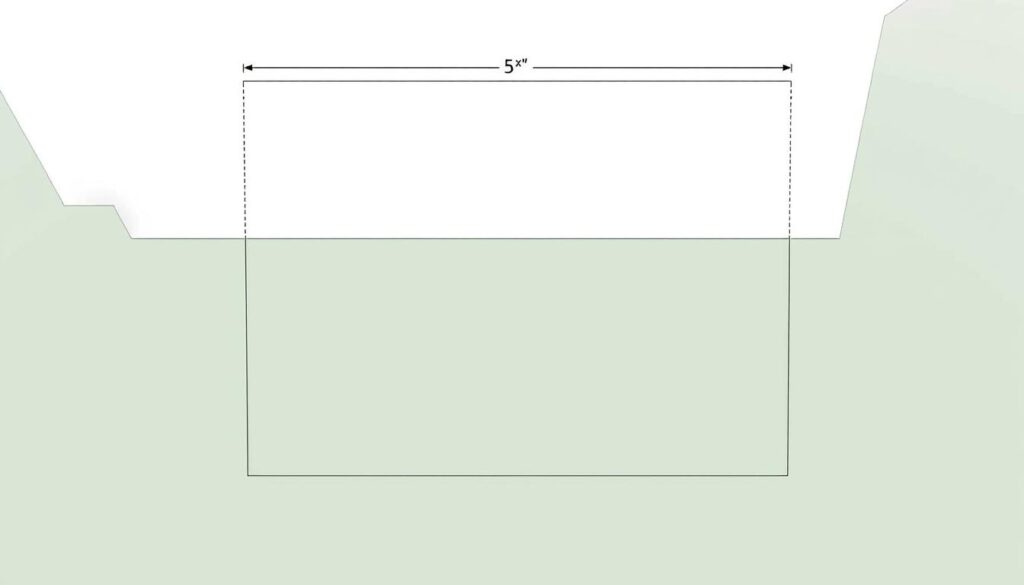
Mounting Hole Patterns
5×8 speaker mounting patterns vary by brand and model. Most use a rectangular or oval pattern with four holes. Some offer extra mounting options.
Measure your speaker’s mounting holes carefully. This helps create an accurate template for installation.
Clearance Requirements
Proper clearance is crucial for good sound. Most 5×8 speakers need at least 3 inches of depth. This allows the speaker cone to move freely.
If space is tight, consider using spacer rings. They can help achieve the right fit.
Accurate measurements are vital for successful installation. Take time to get these details right. If unsure, check your speaker’s manual or contact the manufacturer.
Overlooking small details can cause big problems later. This is similar to home exterior neglect, where minor issues can grow into major concerns.
Creating Your Custom Template
A custom speaker template ensures a perfect fit. This DIY process helps your speakers look and sound great. Let’s explore how to make a speaker cutout guide for your needs.
Template Drawing Techniques
Trace your speaker’s outline on cardboard or plastic. Be precise, as every millimeter counts. Use a flexible ruler to capture curves accurately.
Mark mounting holes clearly for easy transfer later. This step is crucial for proper installation.
Material Selection Tips
Choose your template material carefully. Cardboard is easy to use but less durable. Plastic lasts longer but can be harder to cut.
For a pro-level template, try thin metal sheets. They’re sturdy and can be used multiple times.
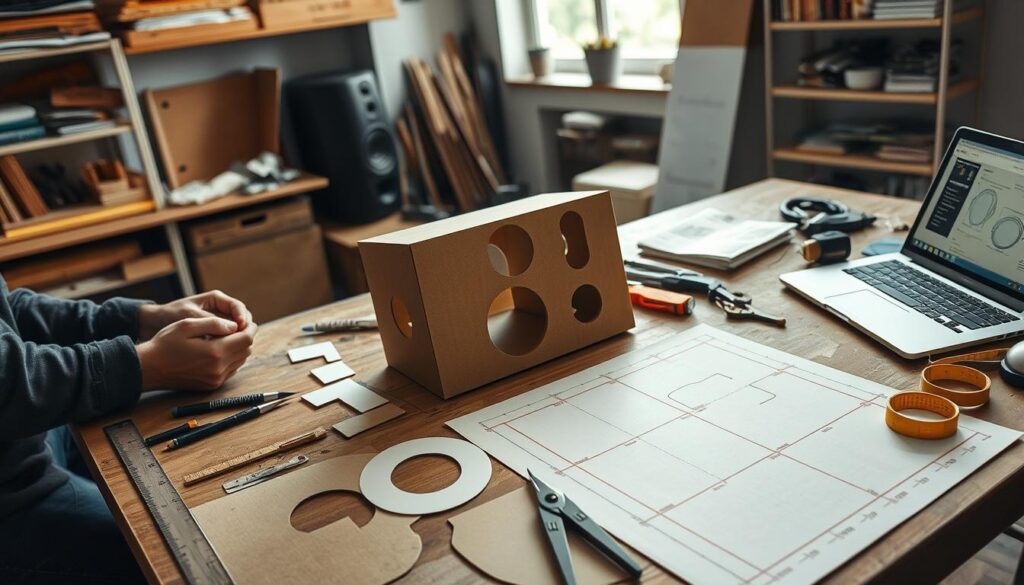
Cutting and Shaping Methods
Cut your template with care. Use sharp scissors for cardboard, a utility knife for plastic, or tin snips for metal. Smooth edges are crucial for accuracy, just like other home improvements.
Test your template before cutting into your vehicle. This step ensures a perfect fit and saves time.
Creating a custom speaker template requires patience. Take your time with measurements and cuts. A well-made template leads to a professional-looking installation.
Speaker Removal and Area Preparation
Removing car speakers is key to upgrading your audio system. Start by detaching factory speaker grills with a plastic pry tool. This helps avoid damaging the surrounding trim.
Unscrew the stock speakers and disconnect the wiring harness gently. Clean the mounting area thoroughly. Remove any debris or old adhesive for a smooth surface.
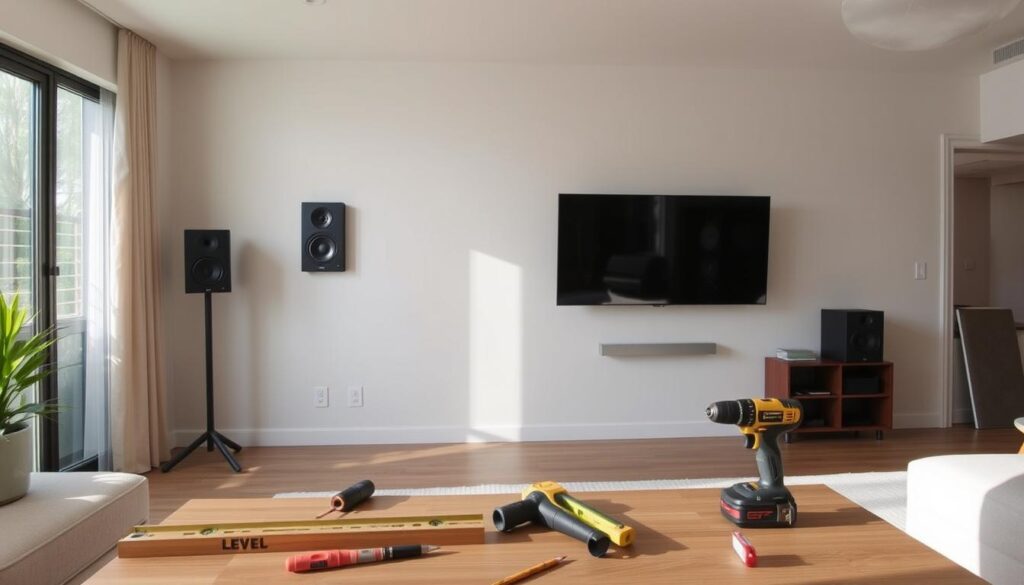
Replacing 6×8 speakers with 6×9 models may require modifying the mounting area. Measure and mark any needed cuts carefully. Consider removing the subwoofer for better access.
Vacuum the area thoroughly to prevent loose debris from interfering. With the area clean, you’re ready for the next phase. Your speaker upgrade project can now move forward smoothly.
Template Positioning and Marking
Proper speaker template alignment is crucial for a successful installation. This step ensures your speakers fit perfectly and look professional. Let’s explore techniques for positioning your template and marking speaker cutouts.
Alignment Techniques
Start by positioning your template centrally in the existing hole. Use a level to ensure it’s straight. Measure the distance from the template edge to nearby landmarks for precise alignment.
This approach helps you achieve symmetry, especially when installing multiple speakers. Accurate positioning sets the foundation for a flawless installation.
Surface Marking Guidelines
Once aligned, it’s time to mark your speaker cutouts. Use a sharpie to trace the template edge on fabric or insulation surfaces.
For metal surfaces, a center punch works best to mark drilling points. Always double-check your measurements before cutting.
- Use contrasting colors for clear visibility
- Mark in short, light strokes to avoid mistakes
- Keep your marking tool perpendicular to the surface
Accurate marking of speaker cutouts is key to a clean installation. Take your time and be precise. A well-marked template leads to perfectly fitted speakers and a polished look.
Cutting and Modification Process
Speaker hole cutting is key in car audio upgrades. It needs precision for a perfect fit. Let’s explore the steps for DIY speaker installation.
Cutting Tools Selection
Pick the right tools for speaker hole cutting. A Dremel with metal cutting wheels offers precision. For bigger jobs, a jigsaw might work better.
Keep spare blades handy. They can dull fast when cutting car body materials.
Step-by-Step Cutting Guide
- Start by cutting through any fabric or upholstery along your template lines.
- Next, carefully cut the metal, following the edge of the insulation.
- Work in small sections, taking breaks to avoid overheating your tools.
- If needed, cut from the trunk side for better control and visibility.
- Double-check your cuts align with your template markings.
Edge Finishing Methods
After cutting, smooth the edges. Use a Dremel grinding attachment or sandpaper to remove sharp points. This step ensures safety and a clean look.
Apply a thin layer of touch-up paint. This prevents rust and completes your DIY speaker installation.
Speaker Installation and Mounting
Installing car speakers doesn’t have to be hard. With the right approach, you can set up your new audio system easily. Let’s explore the key parts of speaker mounting and wiring.
Mounting Hardware Tips
Choosing the right mounting hardware is vital for car speakers. Use gasket material between the speaker frame and metal surface to reduce vibration. Drill mounting holes slightly smaller than the screw diameter for a secure fit.
This creates a tighter grip and prevents loosening over time. A secure fit ensures your speakers stay in place and perform well.
Wiring Considerations
Speaker wiring is a crucial step in installation. Connect your speakers using butt connectors for a solid connection. Consider using both wire sets to make future upgrades easier.
Always double-check the polarity when connecting to ensure the best sound quality. Proper wiring helps your speakers deliver top-notch performance.
Tighten your speakers evenly to prevent warping. This spreads pressure across the speaker frame, improving both performance and lifespan. Following these tips will help you enjoy great sound in your car.



